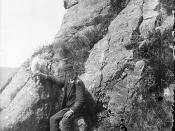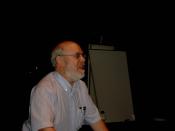In David Bordwell's essay, "The Art Cinema as a Mode of Film Practice", he claims that, "art cinema defines itself explicity againt classic Hollywood cinema practices, in the area of narrative structure, and cinematic style,." In the film, Contempt (1963), directed by Jean Luc Godard, Bordwells claims provide an interesting scope through which to watch the film. In the film, the narrative structure, and cinematic style defy classic Hollywood cinema practices. Contempt uses unique cutting techniques, audio sampling, narrative style, shot compositon, and camera movements, all which can be representative of the Art House genre.
Classic Hollywood narrative style provides audiences with a storyline that goes from A to B, easy to follow, as to be leasing to the masses. The narrative style in Contempt is much different to that of classic Hollywood cinema; the premise of the story is not all that exiting, and simple. The storyline abruptly changes without resolution, defying traditional Hollywood cinema practices.
For example, when the movie producer and Camille leave Paul at the studio after he opts to take a cab and follow them. The two leave, leaving Paul alone at the studio without an address to meet them. In the next scene, Paul somehow finds the house, and when he arrives, Camille is upset he is late. Paul is no longer concerned with them leaving him, and he has an excuse that his taxi got into a crash. Camille is upset for the remainder of the movie, leaving the viewer to ponder why. In classic Hollywood film, the dispute would either have been resolved, or further developed to add to the plot. In the case of contempt, Paul's car accident was never explored, he just mentioned it a few times, and it was forgotten.
What makes an Art House film so unique...


